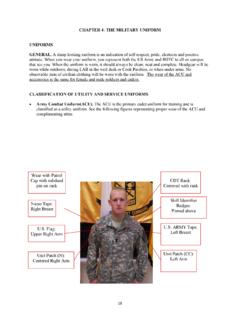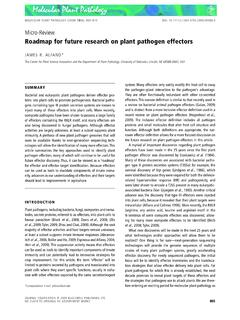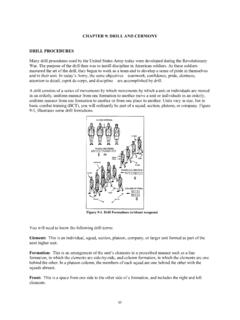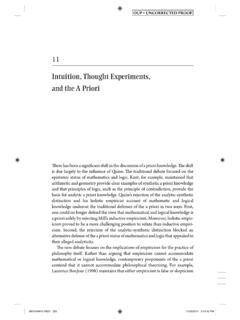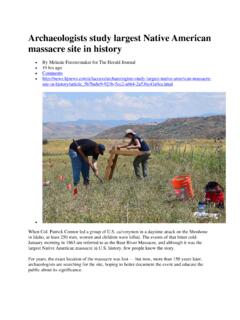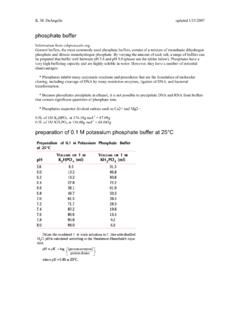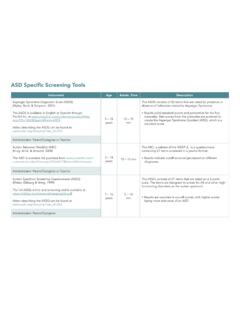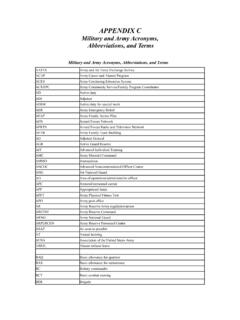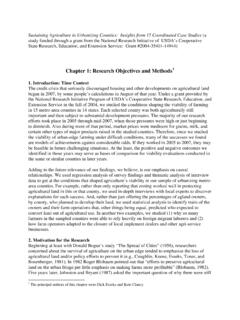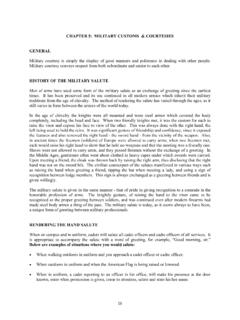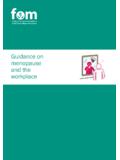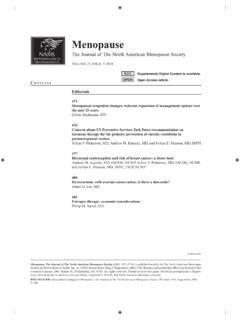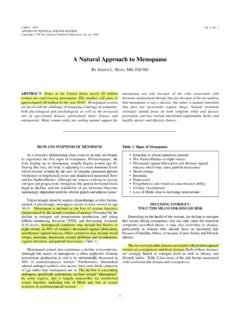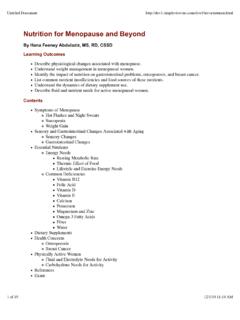Transcription of Menopause: Adaptation or Epiphenomenon?
1 ARTICLESM enopause: Adaptation or Epiphenomenon? JOCELYN SCOTT PECCEIE volutionary biologists consider allcomplex design features of organismsto be ultimately the result of naturalselection. As such, menopause can al-ways be considered an Adaptation . Atthe same time, it is also recognizedthat an Adaptation is always morpho-logically, physiologically, and devel-opmentally constrained by an organ-ism s phylogenetic of origin is whether meno-pause is primarily an Adaptation , inthe sense that selection directly fa-vored a postreproductive life span inhuman females, or whether it is anepiphenomenon of selection for effi-cient early reproduction or physiolog-ical constraints preventing prolonga-tion of fertility in the presence ofincreases in human longevity. The dis-tinction between adaptations, fitnesstrade-offs, and true phylogenetic con-straints is the level of to the role of constraintswithout explanation of why these con-straints themselves are not subject toevolutionary change constitute proxi-mate explanations.
2 Although it is use-ful for heuristic purposes to think interms of three distinct alternatives Adaptation , trade-off, or constraint the explanations overlap and instance, a trade-off is part adap-tation and part constraint. In addi-tion, the question of menopause can-not be isolated from the question ofhuman longevity. In all three cases,the bottom line is that selection favorsearly reproduction relative to lifespan. In this sense, reproductive se-nescence is always premature. In thispaper I critically review the evidencefortheadaptation,physiologicaltr ade-off and by-product of increasedlongevity explanations for the originof ADAPTATIONEXPLANATIONIn the strictly adaptationist view ofmenopause, maternal investment isthe key factor. Human females havemenopause because their hominid an-cestors who ceased reproducing be-fore the end of their lives gained afitness advantage over their still-fertilesisters in that they they could directtheir remaining reproductive effortmore profitably toward enhancing thereproductive success of existing ,5 9,52 54 The fitness trade-off be-tween greater investment in offspringalready born versus producing moreoffspring, amounting to a quality ver-sus quantity trade-off, very likely cul-minated during a time of rapid en-cephalization in the hominine line,which brought with it increases in in-fant altriciality and the prolongationof juvenile ,9,52 54 Withprolonged helplessness and nutri-tional dependence of offspring, eachsuccessive offspring imposed a greatercost on the mother.
3 6in terms of thedepletion of her physical reserves andthe resources available for her to in-vest in existing offspring. With herown survival in question and the fu-ture of her existing offspring at stake,producing late babies with low sur-vival probability was likely to lead toreproductive failure. In this scenario, menopause results from selection forreproductive cessation and is aboutstopping are two not necessarily mutu-ally exclusive, Adaptation grandmother hypothesis is aboutinclusive fitness; the benefit comesfrom increasing the fertility of adultdaughters and nieces, and the sur-vival of their offspring. The princi-pal proponents of this hypothesisare Hawkes, Blurton Jones, andO Connell,7,22,55but many other re-searchers have examined ,3,56 60 The mother hypothesis is about in-creasing the survival and fertility ofone s own ,6,8,9,61,62 Thegrandmother hypothesis of Hawkesand colleagues7,22and has recentlyJocelyn Scott Peccei is a Research Asso-ciate at the Department of Anthropology,University of California Los Angeles, LosAngeles, CA 90095-1553, USA.
4 Words: menopause , life-history evolution, fe-male reproductive strategies, grandmother hy-potheses, follicular atresiaEvolutionary Anthropology 10:43 57 (2001) menopause is a nonfacultative and irreversible cessation of fertility that occursin all female conspecifics well before the senescence of other somatic systems andthe end of the average adult life span (Fig. 1).1 3So defined, menopause occursonly in humans and one species of toothed 4 According to evolutionarytheories of senescence, there should be no selection for postreproductive , evolutionary biologists and anthropologists have long been interestedin why human females have menopause . Many have suggested that menopause isa hominine Adaptation , the result of selection for a postreproductive life span thatpermitted increased maternal investment in existing ,6 9 Others arepersuaded that premature reproductive senescence is an epiphenomenon , eitherthe result of a physiological trade-off favoring efficient reproduction early in thefertile part of life or simply the by-product of increases in life span or life 17 menopause poses two separate questions: why it originated and whatis maintaining it?
5 Evolutionary Anthropology 43evolved from an explanation formenopause into an explanation forthe exceptionally long postreproduc-tive life span of human ,55 Inthe old grandmother hypothesis, menopause is an Adaptation facilitat-ing grandmothering. In the newgrandmother hypothesis, grandmoth-ering is the Adaptation facilitating in-creases in longevity; menopause is hypotheses have receivedmore attention than the mother hy-pothesis, I have argued that both ver-sions of the former are more problem-atic than the mother menopause originated as an ad-aptation for postreproductive mater-nal investment, whether mothering orgrandmothering, conditions had toexist that favored this Adaptation . Box2 lists the important predictions forwhich the evidence supports meno-pause as an Adaptation , followed bythe Adaptation predictions that arenot for IncreasedMaternal InvestmentIf menopause is an Adaptation , weought to find reasons in the course ofhuman evolution for intensification inthe quantity-quality trade-off betweenprolonged fertility and increased ma-ternal investment.
6 Two reasons can beadvanced for substantial increases inmaternal investment in the environ-ment of evolutionary adaptedness:new ecological pressures due tochanges in climate and diet and sec-ondary altriciality of hominid infantsdue to cranial expansion and pressuresCooling and drying trends duringthe Plio-Pleistocene resulted in patch-iness and seasonality in vegetation,necessitating dietary changes for ,63 65 For the hominine line,this dietary shift is believed to haveled to expansion of home ranges, ex-ploitation of a variety of habitats, andincreasing foraging flexibility, includ-ing greater reliance on ,64 70 These changes required increased in-vestment in altricialityIn addition, there were periods of en-cephalization in the hominine 73 Whereas initially the limitation on in-creasing adult brain size was imposedby maternal metabolic output duringgestation, there came a point whenchanges in pelvic dimensions facilitat-ing more efficient bipedal locomotionput a stop to further rapid prenatalbrain resulting compro-mise was that the further rapid braingrowth needed to attain greater adultbrain size had to continue ,71,72 With much organizationaldevelopment in addition to growth stillto take place postnatally,Homoinfantswere born in a state of secondary altri-ciality, requiring intensified investmentin infants and prolonged care of juve-niles.
7 Exactly when these life-historychanges occurred is still debated. Manyresearchers believe major anatomicaland behavioral changes began mya72,75 78(but seeRuff, Trinkhaus, and Holliday79). Re-cent studies agree that maximum lifespan has exceeded 50 years since earlyH. erectus,74,80which could indicatethat menopause is mya. However,earlyH. erectus(H. ergaster) is not gen-erally associated with delayed ,81,82(but see Clegg and Aiello77).The first appearance of delayed matu-rity is estimated at seemsreasonable that changes in rates of de-velopment kept pace with, but followed,increases in both adult brain size andsecondary altriciality during also would be logical toassume that the transformation fromaustralopithecine tohuman-like lifehistories was completed by the timeanatomically modernH. sapiensap-peared on the scene. Thus, meno-pause could have arisen any time be-tween and Unique to HumanFemalesIf a protracted period of postrepro-ductive maternal investment is theresponse to a unique set of socioeco-logical, anatomical, and physiologi-cal pressures, and is also of criticalimportance to the way we evolvedfrom our hominoid ancestors, wewould expect menopause to be uniqueto humans or at least rare in primatesSome decline in age-specific fertilityin later life is not uncommon amongFigure 1.
8 Comparative senescence of physiological functions in human females (redrawnfrom Hill and Hurtado3).44 Evolutionary AnthropologyARTICLES nonhuman , alliteroparous organisms can be ex-pected to exhibit declining fertility asa function of general , in contrast to human fe-males, nonhuman primates and evenlonger-lived species such as elephants,whales, and tortoises retain their ca-pacity to reproduce until very old African female elephants with amaximum life span of about 60 yearsstill retain 50% of their reproductivecapacity at age 55 years, an age whichonly 5% of the population ever 87 Female tortoises remain fer-tile far longer than 60 years,53andbaleen whales are still reproductive intheir exception to thisgeneral animal pattern are short-finnedpilot whales (Globicephala macroryn-chus). In this species, females experi-ence menopause between the ages of 30and 40 years and have a mean survivalof$14 years after 1.
9 Background on MenopauseWe know that menopause has been around for at least3,000 years from a Biblical reference to Sarah in the bookof Genesis (18:11),19which says, it ceased to be withSarah after the manner of women, from which we caninfer not only that Sarah herself had stopped menstruating,but that the authors were quite familiar with the phenom-enon. Although many researchers have speculated thatmenopause is a very old trait,20 22we do not know whethermenopause has been around since the hominoid-hominidsplit,Homo erectus,anatomically modernH. sapiens,orsimply since maximum life spans exceeded 50 years. Thelife span predicted from body and brain size in earlyHomosuggests that a female postreproductive life span predatesH. there is a strong central tendency in the age ofmenopause in developed countries, with medians cluster-ing around 50 years, there is considerable variation in theage of menopause both within and between a sample of American women, the age of menopauseranged from 40 to 59 age within this range isconsidered normal.
10 Across populations, medians rangefrom 43 years in Central Africa to years among Cau-casian heritability estimates of 40% to60% heritability in the age of menopause ,25 27there isplenty of genetic variation to increase or decrease themean age of menopause if such changes brought in-creased fitness. Yet research suggests that there has beenno secular trend of any kind in the age of menopause overthe last 150 31 More importantly, Greek and Ro-man writings suggest that there probably has been little orno secular movement for the last 2,500 years. Aristotle(fourth century ) and Pliny (first century ) give 50years as the maximum age of from theMiddle Ages give 50 years as the average age, with a rangeof 35 to 60 ,34 Physiologically, menopause is the cessation of mensesdue to the depletion of females produceall the oocytes they will ever have by the fifth month ofgestation. Semelgametogenesis, the character of produc-ing all of one s gametes at one time, is a trait common tofemale birds and humans the maximum ofapproximately 7 million oocytes is reduced to 2 million bybirth, 400,000 at puberty, and 1,000 at , which are surrounded by follicles in the ovaries, arelost mostly through a programmed process of cell deathinduced by hormone withdrawal, known as is the sole cause of follicular death before puberty andremains the predominant cause thereafter, because thenumber of follicles lost to ovulation is relatively 400 oocytes are ovulated over the remain inactive in their follicles in an arrestedphase of meiosis from the fifth month of gestation until theyeither succumb to atresia or become part of an , only one oocyte in a cohort is singledout to complete meiosis.
